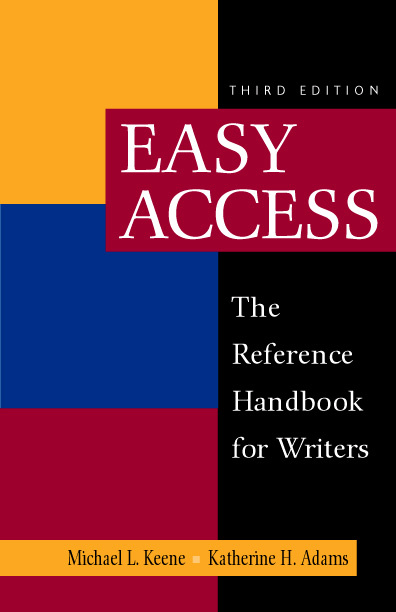 |  Easy Access: The Reference Handbook for Writers, 3/e Michael L. Keene,
The University of Tennessee, Knoxville
Katherine H. Adams,
Loyola University New Orleans
Table of ContentsHow to Use This Handbook
Preface and Acknowledgments
PART I. PROCESSES AND PRODUCTS
1. The Writing Process
Prewriting / Planning / Drafting / Revising / Finishing
2. Research Writing
Analyze the Assignment / Plan a Research Strategy / Do Your Research / Take Good Notes and Keep Good Records / Choose a Preliminary Thesis and Outline / Write the First Draft / Use Your Sources Effectively / Revisit Your Research as Necessary / Revise and Edit Systematically / Document Your Sources Correctly / Sample Research Paper (MLA Style)
3. Argumentation
Choose a Thesis and Plan Key Assertions / Employ the Rhetoric of Argument / Acknowledge Opposing Views (Refutation) / Read Your Own and Other Arguments Critically / Sample Argument Paper (APA Style)
4. MLA Documentation Style
Citations in the Text / List of Works Cited / Typing or Word Processing Instructions for MLA
5. APA Documentation Style
Citations in the Text / Reference List / Typing or Word Processing Instructions for APA
6. Document Design
Short Papers / Longer Research Papers and Reports / Web Pages
7. Special Writing Situation
Writing about Literature / Essay Exams / Professional Communication / Oral Presentations
PART II. COMMON WRITING PROBLEMS
8. Sentence Fragments
Quick View / Testing for Fragments—In Detail / Revising Fragments / Practice
9. Comma Splices
Quick View / Revising Comma Splices / Practice
10. Run-On Sentences
Quick View / Revising Run-On Sentences / Practice
11. Verb Errors
Quick View / Subject-Verb Agreement Errors / Form Errors / Inappropriate Shifts in Tense / Inappropriate Shifts in Mood / Practice
12. Using Commas
Quick View / Correct Uses of Commas / Incorrect Uses of Commas / Practice
13. Pronoun Errors
Quick View / Vague or Ambiguous Pronoun Reference / Lack of Agreement between Pronoun and Antecedent / Inappropriate Shifts in Person / Biased Uses of Pronouns / Practice
14. Using Apostrophes
Quick View / Apostrophes in the Possessive Case / Apostrophes in Contractions / Apostrophes to Form Plurals of Letters and Numerals / Its versus It’s and Other Pronoun Homonyms / Practice
15. Problems with Modifiers
Quick View / Misplaced Modifiers / Dangling Modifiers / Squinting Modifiers / Overstacked Modifiers / Improper Adverb or Adjective Forms / Practice
16. Faulty Parallelism
Quick View / Items in Lists / Items Joined by Coordinating Conjunctions / Parts of a Sentence Joined by Correlative Conjunctions / Comparisons or Contrasts / Practice
17. Mixed Constructions
Quick View / Mismatched Subject and Predicate / Mismatched Clauses / Mismatches with Is When, Is Where, or The Reason … Is Because / Practice
18. For Multilingual/ESL Writers
Quick View / Articles and Nouns / Adjectives / Adverbs / Prepositions / Verbs / Sentence Structure / Practice
PART III. THE BASICS FROM A TO Z
GLOSSARY OF USAGE
INDEX
Credits
Quick Views
A Checklist for Finishing Your Paper
Revision and Correction Symbols (inside back flap)
Frequently Asked Questions (outside back flap)
|
|



 2002 McGraw-Hill Higher Education
2002 McGraw-Hill Higher Education